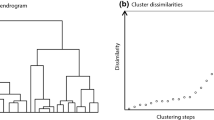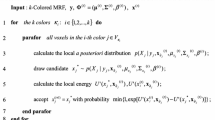Abstract
Stationary segments in well log sequences can be automatically detected by searching for change points in the data. These change points, which correspond to abrupt changes in the statistical nature of the underlying process, can be identified by analysing the probability density functions of two adjacent sub-samples as they move along the data sequence. A statistical test is used to set a significance level of the probability that the two distributions are the same, thus providing a means to decide how many segments comprise the data by keeping those change points that yield low probabilities. Data from the Ocean Drilling Program were analysed, where a high correlation between the available core-log lithology interpretation and the statistical segmentation was observed. Results show that the proposed algorithm can be used as an auxiliary tool in the analysis and interpretation of geophysical log data for the identification of lithology units and sequences.
Similar content being viewed by others
References
Davis J (1986) Statistics and data analysis in geology. Wiley, New York, p 646
Gill D (1970) Application of a statistical zonation method to reservoir evaluation and digitized-log analysis. Am Assoc Pet Geol Bull 54(5):719–729
Gill D, Shomrony A, Fligelman H (1993) Numerical zonation of log suites and logfacies recognition by multivariate clustering. Am Assoc Pet Geol Bull 77(10):1781–1791
Hawkins DM, Merriam DF (1973) Optimal zonation of digitized sequential data. Math Geol 5(4):389–395
Kaaresen KF, Taxt T (1998) Multichannel blind deconvolution of seismic signals. Geophysics 63(6):2093–2107
Ligges U, Weihs C, Hasse-Becker P (2002) Detection of locally stationary segments in time series. In: Härdle W, Rönz B (eds) Proc. of the 15th conference on computational statistics. Physika, Heidelberg, pp 285–290
Press WH, Teukolsky S, Vetterling W, Flannery B (1992) Numerical recipes in FORTRAN: the art of scientific computing, 2nd edn. Cambridge University Press, New York
Tarduno JA, Duncan RA, Scholl DW (2002) Motion of the Hawaiian hotspot: a paleomagnetic test. In: Proc. ODP, initial reports, vol 197, available from Word Wide Web: http://www-odp.tamu.edu/publications/197_IR
Velis DR (2003) Estimating the distribution of primary reflection coefficients. Geophysics 68(4):1417–1422
Webster R (1973) Automatic soil-boundary location from transect data. Math Geol 5(1):27–37
Yilmaz Ö (2001) Seismic data analysis: processing, inversion, and interpretation of seismic data. Society of Exploration Geophysicists, Tulsa
Author information
Authors and Affiliations
Corresponding author
Rights and permissions
About this article
Cite this article
Velis, D.R. Statistical Segmentation of Geophysical Log Data. Math Geol 39, 409–417 (2007). https://doi.org/10.1007/s11004-007-9103-y
Received:
Accepted:
Published:
Issue Date:
DOI: https://doi.org/10.1007/s11004-007-9103-y




